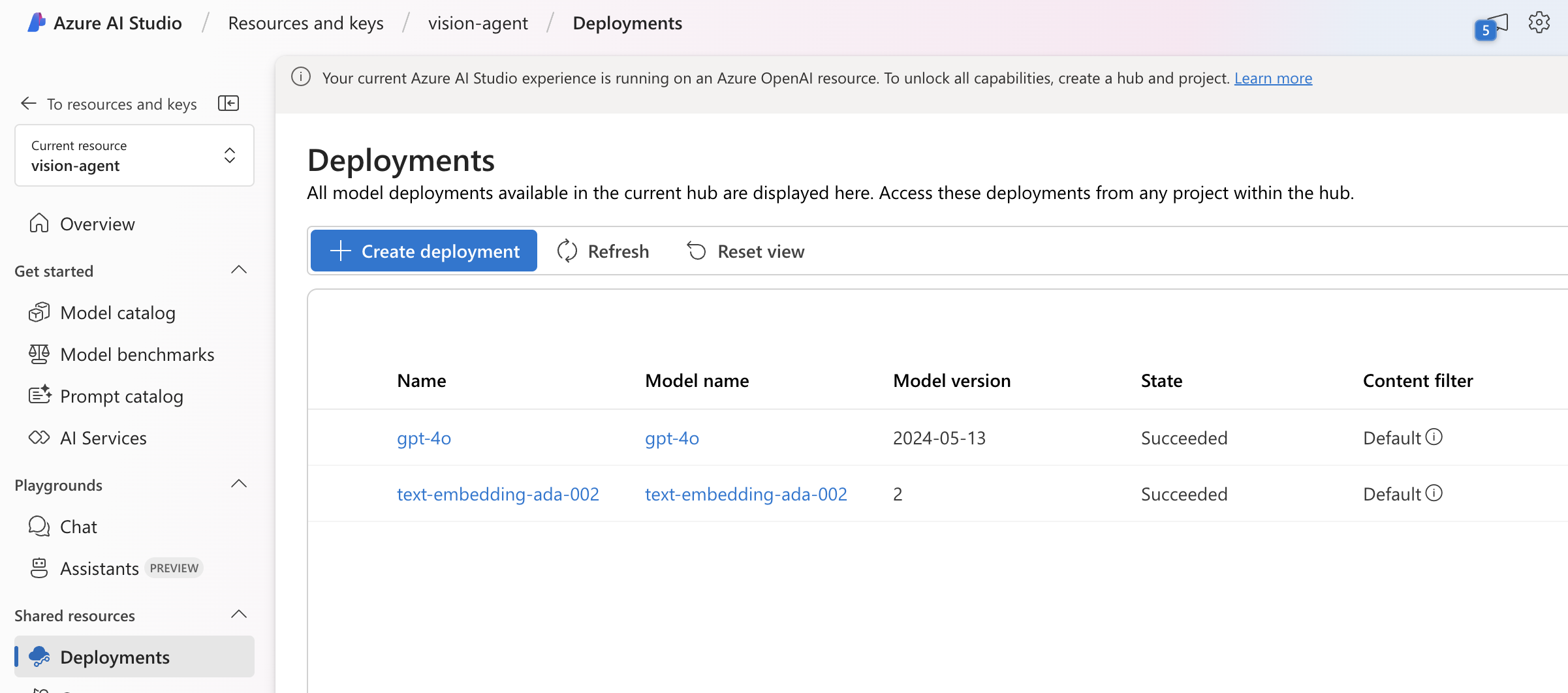Toolset for Vision Agent
Project description
Vision Agent is a library that helps you utilize agent frameworks to generate code to solve your vision task. Many current vision problems can easily take hours or days to solve, you need to find the right model, figure out how to use it and program it to accomplish the task you want. Vision Agent aims to provide an in-seconds experience by allowing users to describe their problem in text and have the agent framework generate code to solve the task for them. Check out our discord for updates and roadmaps!
Web Application
Try Vision Agent live on va.landing.ai
Documentation
Getting Started
Installation
To get started, you can install the library using pip:
pip install vision-agent
Ensure you have an OpenAI API key and set it as an environment variable (if you are using Azure OpenAI please see the Azure setup section):
export OPENAI_API_KEY="your-api-key"
Vision Agent
Basic Usage
You can interact with the agent as you would with any LLM or LMM model:
>>> from vision_agent.agent import VisionAgent
>>> agent = VisionAgent()
>>> code = agent("What percentage of the area of the jar is filled with coffee beans?", media="jar.jpg")
Which produces the following code:
from vision_agent.tools import load_image, grounding_sam
def calculate_filled_percentage(image_path: str) -> float:
# Step 1: Load the image
image = load_image(image_path)
# Step 2: Segment the jar
jar_segments = grounding_sam(prompt="jar", image=image)
# Step 3: Segment the coffee beans
coffee_beans_segments = grounding_sam(prompt="coffee beans", image=image)
# Step 4: Calculate the area of the segmented jar
jar_area = 0
for segment in jar_segments:
jar_area += segment['mask'].sum()
# Step 5: Calculate the area of the segmented coffee beans
coffee_beans_area = 0
for segment in coffee_beans_segments:
coffee_beans_area += segment['mask'].sum()
# Step 6: Compute the percentage of the jar area that is filled with coffee beans
if jar_area == 0:
return 0.0 # To avoid division by zero
filled_percentage = (coffee_beans_area / jar_area) * 100
# Step 7: Return the computed percentage
return filled_percentage
To better understand how the model came up with it's answer, you can run it in debug mode by passing in the verbose argument:
>>> agent = VisionAgent(verbose=2)
Detailed Usage
You can also have it return more information by calling chat_with_workflow. The format
of the input is a list of dictionaries with the keys role, content, and media:
>>> results = agent.chat_with_workflow([{"role": "user", "content": "What percentage of the area of the jar is filled with coffee beans?", "media": ["jar.jpg"]}])
>>> print(results)
{
"code": "from vision_agent.tools import ..."
"test": "calculate_filled_percentage('jar.jpg')",
"test_result": "...",
"plan": [{"code": "...", "test": "...", "plan": "..."}, ...],
"working_memory": ...,
}
With this you can examine more detailed information such as the testing code, testing results, plan or working memory it used to complete the task.
Multi-turn conversations
You can have multi-turn conversations with vision-agent as well, giving it feedback on the code and having it update. You just need to add the code as a response from the assistant:
agent = va.agent.VisionAgent(verbosity=2)
conv = [
{
"role": "user",
"content": "Are these workers wearing safety gear? Output only a True or False value.",
"media": ["workers.png"],
}
]
result = agent.chat_with_workflow(conv)
code = result["code"]
conv.append({"role": "assistant", "content": code})
conv.append(
{
"role": "user",
"content": "Can you also return the number of workers wearing safety gear?",
}
)
result = agent.chat_with_workflow(conv)
Tools
There are a variety of tools for the model or the user to use. Some are executed locally while others are hosted for you. You can also ask an LMM directly to build a tool for you. For example:
>>> import vision_agent as va
>>> llm = va.llm.OpenAILMM()
>>> detector = llm.generate_detector("Can you build a jar detector for me?")
>>> detector(va.tools.load_image("jar.jpg"))
[{"labels": ["jar",],
"scores": [0.99],
"bboxes": [
[0.58, 0.2, 0.72, 0.45],
]
}]
You can also add custom tools to the agent:
import vision_agent as va
import numpy as np
@va.tools.register_tool(imports=["import numpy as np"])
def custom_tool(image_path: str) -> str:
"""My custom tool documentation.
Parameters:
image_path (str): The path to the image.
Returns:
str: The result of the tool.
Example
-------
>>> custom_tool("image.jpg")
"""
return np.zeros((10, 10))
You need to ensure you call @va.tools.register_tool with any imports it might use and
ensure the documentation is in the same format above with description, Parameters:,
Returns:, and Example\n-------. You can find an example use case here.
Azure Setup
If you want to use Azure OpenAI models, you need to have two OpenAI model deployments:
- OpenAI GPT-4o model
- OpenAI text embedding model

Then you can set the following environment variables:
export AZURE_OPENAI_API_KEY="your-api-key"
export AZURE_OPENAI_ENDPOINT="your-endpoint"
# The deployment name of your Azure OpenAI chat model
export AZURE_OPENAI_CHAT_MODEL_DEPLOYMENT_NAME="your_gpt4o_model_deployment_name"
# The deployment name of your Azure OpenAI text embedding model
export AZURE_OPENAI_EMBEDDING_MODEL_DEPLOYMENT_NAME="your_embedding_model_deployment_name"
NOTE: make sure your Azure model deployment have enough quota (token per minute) to support it. The default value 8000TPM is not enough.
You can then run Vision Agent using the Azure OpenAI models:
import vision_agent as va
agent = va.agent.AzureVisionAgent()
Project details
Release history Release notifications | RSS feed
Download files
Download the file for your platform. If you're not sure which to choose, learn more about installing packages.
Source Distribution
Built Distribution
File details
Details for the file vision_agent-0.2.68.tar.gz.
File metadata
- Download URL: vision_agent-0.2.68.tar.gz
- Upload date:
- Size: 1.0 MB
- Tags: Source
- Uploaded using Trusted Publishing? No
- Uploaded via: poetry/1.4.2 CPython/3.10.11 Linux/6.5.0-1022-azure
File hashes
| Algorithm | Hash digest | |
|---|---|---|
| SHA256 | 21b313f24eb994d573e54fb87502bd32477ced3d7d79158ce7066115850cfa79 |
|
| MD5 | 2c7d21c4cc16368bb5e6d2d85c9b4abf |
|
| BLAKE2b-256 | b07b90de146ada0a95d0e609c10306ab320fcae0956f8f4524213795cadffab3 |
File details
Details for the file vision_agent-0.2.68-py3-none-any.whl.
File metadata
- Download URL: vision_agent-0.2.68-py3-none-any.whl
- Upload date:
- Size: 1.0 MB
- Tags: Python 3
- Uploaded using Trusted Publishing? No
- Uploaded via: poetry/1.4.2 CPython/3.10.11 Linux/6.5.0-1022-azure
File hashes
| Algorithm | Hash digest | |
|---|---|---|
| SHA256 | 98556d9986711c0e50c5abae0a7671532d94dfdad9c5f435bd03377ec7b6228b |
|
| MD5 | 094449aad9d5b84a0b42657c7a21a351 |
|
| BLAKE2b-256 | abde5cc00c6bfd4dcb8a2d242a19bbb88830bf82b87f75a39df523e9893d842b |
















